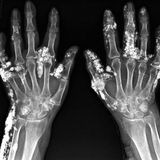
There are several diagnostic imaging methods used in pulmonary inflammation. Some of the commonly used techniques include: Chest X-ray: A chest X-ray is often the first imaging test performed to evaluate pulmonary inflammation. It can provide an initial assessment of the lungs and detect abnormalities such as infiltrates, consolidations, and pleural effusions. However, it may not be as sensitive or specific as other imaging modalities. Computed Tomography (CT) scan: CT scan is a more detailed imaging technique that can provide cross-sectional images of the lungs. It is particularly useful in assessing pulmonary inflammation because it can detect small lesions, assess the extent and distribution of inflammation, and differentiate between different types of lung abnormalities. CT scans can help identify features such as ground-glass opacities, nodules, consolidations, and bronchial wall thickening. Magnetic Resonance Imaging (MRI): While less commonly used than CT scans, MRI can also be utilized to assess pulmonary inflammation. It provides excellent soft tissue contrast and can detect certain lung abnormalities, such as infiltrates and pleural involvement. MRI is particularly valuable when evaluating lung lesions that are difficult to visualize using other imaging methods, or when ionizing radiation needs to be avoided, such as in pregnant women. Positron Emission Tomography (PET) scan: PET scans can be helpful in identifying areas of active inflammation in the lungs. By injecting a radioactive tracer into the body, PET scans can detect increased metabolic activity, which can be indicative of inflammation or infection. PET scans are often used in conjunction with CT scans to provide additional information about the nature and extent of pulmonary inflammation. Ultrasound: Ultrasound is not commonly used as a standalone modality for assessing pulmonary inflammation but can be useful in certain situations. It is often employed to guide procedures such as thoracentesis (draining fluid from the pleural space) or to evaluate the pleura for signs of inflammation, infection, or effusion.



